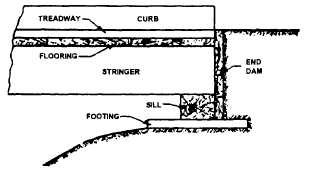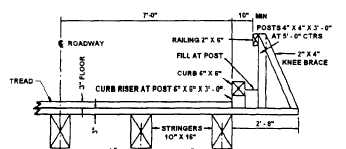timber-nailing anchorage for flooring to the top of a
steel girder.
Timber decking consists of two layers of 3-inch
planks. The lower layer, called the flooring, is laid at
right angles to the stringers and nailed with two 60d
spikes to each stringer crossing. The upper layer, called
the tread (fig. 10-7), is laid securely and nailed at a 90°
angle to the flooring.
Most of the flooring planks and all of the tread
planks are cut to lengths that will bring the ends of the
planks flush with the outer faces of the outside stringers.
However, at 5-foot intervals along the superstructure, a
flooring plank is left long enough to extend 2 feet 8
inches beyond the outer faces of the outside stringers,
The extension serves as support for the curb risers, the
curb, and the handrail posts, as shown in figure 10-7.
The curb risers consist of 3-foot lengths of 6 by 6
timbers, one of which is set in front of each handrail
post as shown. A continuous 2 by 6 handrail is nailed
to 4 by 4 handrail posts. Each handrail post is supported
by a 2 by 4 knee brace, as shown.
An end dam, such as that shown in figure 10-8, is
set at each end of the superstructure. This prevents the
approach of the road to the trestle from washing out
or eroding between the abutment and the girders.
PILE DRIVING TERMINOLOGY AND
TECHNIQUES
LEARNING OBJECTIVE: Upon completing
this section, you should be able to identify the
types of piles used in heavy construction and
state the procedures for constructing a timber
pier.
The principal structural members in many
waterfront structures are piles. There are different
types of and uses for piles. The common terms used
with piles and pile driving are explained below.
Figure 10-7.-Details of superstructure of a timber trestle.
Figure 10-8.-End dam.
TYPES OF PILES
A pile is a load-bearing member made of timber,
steel, concrete, or a combination of these materials. It
is usually forced into the ground to transfer the load
to underlying soil or rock layers when the surface soils
at a proposed site are too weak or compressible to
provide enough support.
Timber Bearing
Timber bearing piles are usually straight tree
trunks cut off above ground swell with the branches
closely trimmed and the bark removed. Occasionally,
sawed timbers may be used as bearing piles.
CHARACTERISTICS.— A good timber pile has
the following characteristics:
It is free of sharp bends, large or loose knots,
shakes, splits, and decay.
It is uniformly tapered from butt to tip.
The centers of the butt and tip are end points of
a straight line that lies within the body of the
pile.
Cross-section dimensions for timber piles should
be as follows:
Piles shorter than 40 feet, tip diameters between
8 and 11 inches, and butt diameters between 12
and 18 inches.
Piles longer than 40 feet, tip diameters between
6 and 8 inches, and butt diameters between 13
and 20 inches. The butt diameter must not be
greater than the distance between the pile leads.
PREPARATION FOR DRIVING.— Timber
piles can be damaged while being driven, particularly
under hard-driving conditions. To protect a pile against
damage, cut the butt of the pile squarely (so the pile
hammer will strike it evenly) and chamfer it. When a
10-4



